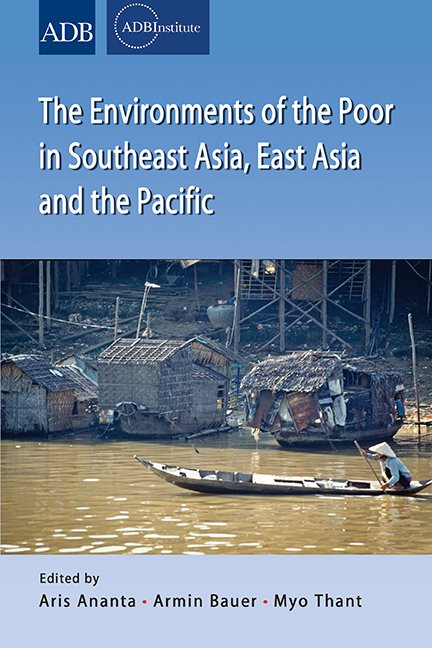Book contents
- Frontmatter
- Contents
- Preface
- List of Contributors
- Part I OVERVIEW
- Part II EAST ASIA (People's Republic of China and Republic of Korea)
- Part III PACIFIC ISLANDS
- Part IV MAINLAND SOUTHEAST ASIA (Cambodia, Thailand, Vietnam)
- Part V ARCHIPELAGIC SOUTHEAST ASIA (Indonesia, Malaysia, Philippines)
- 13 The Political Economy of Environmental Policy in Indonesia
- 14 Prospering in Environmental Degradation: An Illustration from an Upland Area, South Kalimantan, Indonesia
- 15 Making a Living in the Face of Environmental Change: A Case in an Indigenous Community in Sarawak, Malaysia
- 16 The Response of Rural Coastal Households to Typhoon Milenyo in the Philippines
- 17 Life Along Manila's Flooding Rivers
- 18 Quantifying the Health Risks from Pathogens in the Flood Water in Metro Manila
19 - Slum Poverty in the Philippines: Can the Environment Agenda Drive Public Action?
from Part V - ARCHIPELAGIC SOUTHEAST ASIA (Indonesia, Malaysia, Philippines)
Published online by Cambridge University Press: 21 October 2015
- Frontmatter
- Contents
- Preface
- List of Contributors
- Part I OVERVIEW
- Part II EAST ASIA (People's Republic of China and Republic of Korea)
- Part III PACIFIC ISLANDS
- Part IV MAINLAND SOUTHEAST ASIA (Cambodia, Thailand, Vietnam)
- Part V ARCHIPELAGIC SOUTHEAST ASIA (Indonesia, Malaysia, Philippines)
- 13 The Political Economy of Environmental Policy in Indonesia
- 14 Prospering in Environmental Degradation: An Illustration from an Upland Area, South Kalimantan, Indonesia
- 15 Making a Living in the Face of Environmental Change: A Case in an Indigenous Community in Sarawak, Malaysia
- 16 The Response of Rural Coastal Households to Typhoon Milenyo in the Philippines
- 17 Life Along Manila's Flooding Rivers
- 18 Quantifying the Health Risks from Pathogens in the Flood Water in Metro Manila
Summary
In 2010, the projected population of the Philippines was 94 million. Of this population, 18.8 per cent (5 million) live in slums. Of the slum population, 80 per cent (4 million) live in cities. Between 2000 and 2006, the urban slum population grew at an annual rate of 3.4 per cent overall, but 8 per cent in Metro Manila (Table 19.1). Metro Manila, which accounts for 37 per cent of the Philippines’ GDP and 13 per cent of its employment, is home to about 2 million slum dwellers. That makes up 16 per cent of the city's population of 11.5 million (2010). Metro Manila is a rapidly growing megacity. It ranks fourteenth among the twenty megacities of the world. Its population is projected to reach almost 15 million by 2025 (UNCHS 2010).
The incidence of poverty in the cities is 19 per cent. This is much lower than rural poverty of over 50 per cent (the national average is 32 per cent). Still, shelter deprivation is high in urban areas. It is in cities that disparities in living standards and access to basic services and infrastructure are most evident. We observe rich, well-serviced neighbourhoods and dense slum settlements existing in proximity to each other.
Households in slums are not necessarily income poor. About 32 per cent of the urban slum population in Manila (or about 1.3 million people as of 2010) — high compared to the overall poverty incidence — is poor based on national poverty lines of 20,688 pesos per capita (about US$2 in PPP 2010) (Table 19.2). More than 50 per cent live above the poverty line and can spend between US$2 and US$4 per day, but reside in poor environments. The slum-dwellers who live above the poverty line usually make minimum salaries or wages and work casually. They continue living in the slums because there is no alternative shelter in the city and “they cannot afford the cost of travelling from distant, less expensive, peri-urban regions for work and income earning opportunities in urban centers”.
- Type
- Chapter
- Information
- Publisher: ISEAS–Yusof Ishak InstitutePrint publication year: 2013



